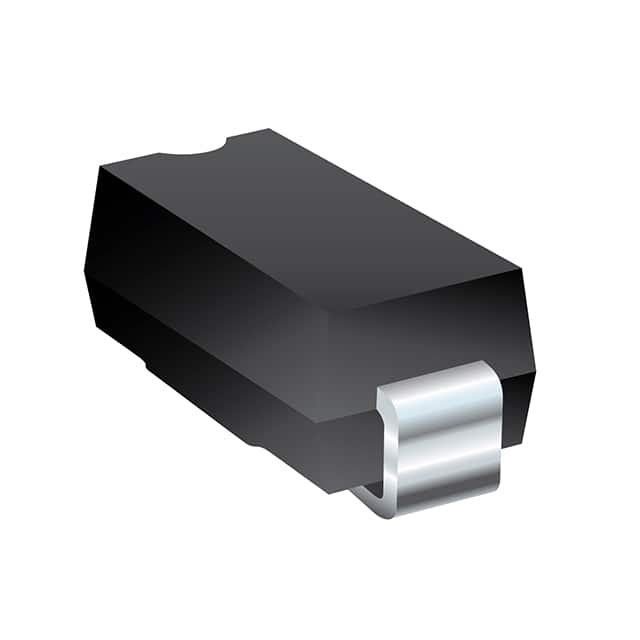Lihat spesifikasi untuk detail produk.

SMAJ64CA Product Overview
Introduction
The SMAJ64CA is a diode belonging to the category of transient voltage suppressor (TVS) diodes. These diodes are commonly used to protect sensitive electronic components from voltage spikes and transients.
Basic Information Overview
- Category: Transient Voltage Suppressor Diode
- Use: Protection against voltage spikes and transients
- Characteristics: Fast response time, low clamping voltage
- Package: SMA (DO-214AC)
- Essence: Safeguarding electronic circuits from voltage surges
- Packaging/Quantity: Available in tape and reel packaging, quantity varies by manufacturer
Specifications
- Part Number: SMAJ64CA
- Peak Pulse Power: 400W
- Breakdown Voltage: 64V
- Operating Temperature Range: -55°C to +150°C
- Storage Temperature Range: -55°C to +150°C
Detailed Pin Configuration
The SMAJ64CA diode has a standard SMA package with two leads. The anode is connected to the positive side of the circuit, while the cathode is connected to the ground or negative side.
Functional Features
- Transient Voltage Suppression: The diode quickly responds to voltage spikes, diverting excess current away from sensitive components.
- Low Clamping Voltage: Ensures that the protected circuit is exposed to minimal voltage during a transient event.
Advantages and Disadvantages
Advantages
- Effective protection against voltage transients
- Fast response time
- Compact and easy to integrate into circuit designs
Disadvantages
- Limited power dissipation capability
- May require additional components for comprehensive surge protection
Working Principles
When a voltage spike occurs, the diode conducts current and shunts the excess energy to the ground, preventing it from reaching the sensitive components in the circuit. This action helps to limit the voltage across the protected circuit.
Detailed Application Field Plans
The SMAJ64CA diode finds applications in various electronic systems, including: - Power supply units - Communication equipment - Automotive electronics - Industrial control systems
Detailed and Complete Alternative Models
- Alternative Model 1: P6KE68CA
- Breakdown Voltage: 68V
- Package: DO-15
- Alternative Model 2: 1.5KE75CA
- Breakdown Voltage: 75V
- Package: DO-201
In conclusion, the SMAJ64CA transient voltage suppressor diode offers effective protection against voltage spikes and transients, making it an essential component in safeguarding sensitive electronic circuits.
Word Count: 386
Sebutkan 10 pertanyaan dan jawaban umum terkait penerapan SMAJ64CA dalam solusi teknis
What is SMAJ64CA?
- SMAJ64CA is a type of transient voltage suppressor diode used to protect electronic circuits from voltage spikes and transients.
What is the maximum working voltage of SMAJ64CA?
- The maximum working voltage of SMAJ64CA is 64 volts.
What is the peak pulse power of SMAJ64CA?
- The peak pulse power of SMAJ64CA is typically 400 watts.
How does SMAJ64CA protect electronic circuits?
- SMAJ64CA diverts excessive current away from sensitive components when a voltage spike occurs, preventing damage to the circuit.
What are the typical applications of SMAJ64CA?
- SMAJ64CA is commonly used in surge protection for telecommunications equipment, power supplies, and automotive electronics.
What is the response time of SMAJ64CA?
- The response time of SMAJ64CA is very fast, typically in the nanosecond range.
Can SMAJ64CA be used for overvoltage protection in solar power systems?
- Yes, SMAJ64CA can be used to protect solar power systems from lightning-induced surges and other overvoltage events.
Is SMAJ64CA suitable for high-speed data lines?
- Yes, SMAJ64CA is suitable for protecting high-speed data lines such as USB, Ethernet, and HDMI interfaces.
What is the operating temperature range of SMAJ64CA?
- The operating temperature range of SMAJ64CA is typically -55°C to 150°C.
Are there any polarity considerations when using SMAJ64CA?
- No, SMAJ64CA is a bidirectional transient voltage suppressor, meaning it can protect against positive and negative voltage transients equally.

